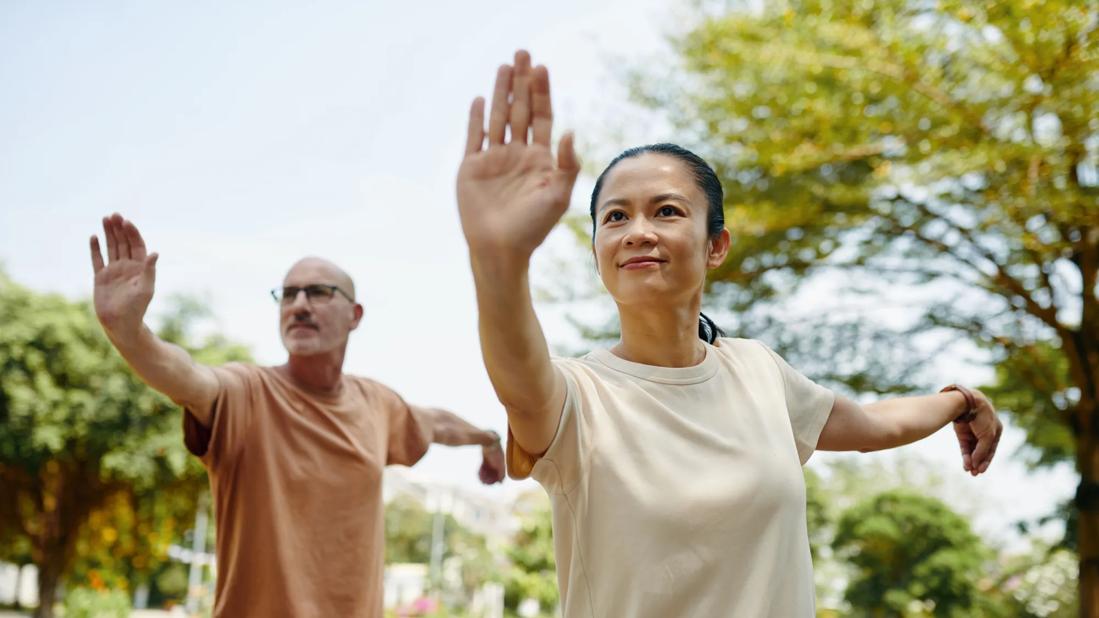Being truly present in your body while you work out may reduce stress, heal trauma and more

What if you ditched the fitness trackers, vision boards and personal bests and focused on how moving your body feels instead?
Advertisement
Cleveland Clinic is a non-profit academic medical center. Advertising on our site helps support our mission. We do not endorse non-Cleveland Clinic products or services. Policy
Exercise physiologist David Creel, PhD, explains what somatic movement is and how applying somatic principles to your workout benefits your mind and body.
Somatic movement is a mindfulness method you can apply to physical activity. A somatic workout doesn’t focus on form, goals or competition. It revolves around how your body feels. Somatic movement and stretching are about being present in the moment, listening to your body and practicing focused, intentional movements.
Dr. Creel says that some types of exercise have somatic methods built into them, such as:
Advertisement
Those are some of the most common somatic exercises and stretches. But almost any movement can be somatic. Dr. Creel, for example, made his morning bike ride to work somatic. Instead of thinking about how fast he was going or how to push himself further, he looked inward.
“I thought about how my legs felt as they moved,” he shares. “I focused on how my feet were grounded on the pedals and energy seemed to flow to them. I noticed my quads contracting as I pushed the pedals down and how my hamstrings felt pulling them back up. And I paid attention to my breathing.”
There’s very little research on the health benefits of somatic exercises. The research that does exist has a narrow focus, looking only at specific types or schools of somatic movement.
Thankfully, there’s lots of research on the benefits of physical activity for everything from your heart health to your memory. Ditto for mindfulness and the many exercises we’ve mentioned here.
Dr. Creel explains seven potential benefits of somatic movement.
Like any other fitness practice, somatic exercise can improve your physical health. They may:
Somatic movement and stretching support proprioception, an understanding of where your body is — and how it moves — in space. It’s crucial for balance and coordination. It can also dim as we get older. Practicing somatic movement may help you stay agile and active longer.
Exercise is a mood booster. It releases happy hormones like serotonin, dopamine and endorphins. At the same time, it reduces the level of stress hormones in your body. The result is a clearer, sharper mind and a boosted mood.
And getting out of the house to exercise with other people? That can be great for your mental health, too.
Trauma can make you feel uncomfortable in (or disassociated from) your body. Somatic movement techniques like yoga can be a gentle way to reconnect.
Dr. Creel recommends working with a trauma-informed instructor alongside a therapist who specializes in trauma. Together, these interventions may help you process any feelings that surface while also respecting your boundaries.
According to Dr. Creel, if you learn how to move mindfully, you can practice mindfulness in other areas of life, too. For example:
Advertisement
Whether you’re 4, 47 or 104, there’s a somatic exercise out there for you. And your current fitness level is a great place to start. Just check with your provider beforehand. And if you’re feeling a little extra creaky or something hurts, stop or adjust your workout as needed.
You don’t have to be great at the exercises you do. You just have to have fun.
“If you focus on how unfit you are, you’re setting yourself up to be discouraged and unhappy,” Dr. Creel warns. “Somatic movement is about taking some of that pressure away.”
Dr. Creel says somatic movement encourages exploration, reflection and acceptance. That can translate into a deep sense of spiritual connection. Your practice doesn’t have to involve a spiritual component. But the potential is there, if you want it.
Anybody can apply somatic methods to their fitness routine. But some have used its principles to develop specific somatic workout methods, schools and styles. If you’re looking for a somatic exercise instructor, Dr. Creel suggests choosing someone who has specialized training in somatic movement along with:
Advertisement
It’s important to find the right fit, so walk away if you aren’t comfortable with a studio, class or instructor. The beauty of somatic movement is that you can always do it yourself. You just have to (literally) put your mind to it.
Advertisement
Learn more about our editorial process.
Advertisement

Lower-intensity workouts can deliver high-quality health and fitness results

Incremental changes in your exercise routine can improve your strength and endurance over time

Understanding heart rate zones can help you tailor your workout to reach your goals

Increase the size of your muscles by bulking up on protein and focusing on slow, intense movements with progressive overloading

Low-impact exercises help you recover faster between sets, during cool downs and on rest days

Eccentric is slow and steady, while concentric is fast and controlled

Weightlifting can help you build muscle mass, reduce joint pain and increase flexibility to improve your quality of life

Abdominal exercises don’t have to be done on the floor!

Babies can get congested easily, but you can calm their cough by keeping them hydrated, using nasal drops and running a humidifier

Weight loss may cause loose, sagging skin and muscle loss to your rear

Several conditions, like vitiligo and fungal infection, can cause a loss of pigmentation, leading to white spots or patches on your skin